 BT has today set-up a new division, known as OpenReach. They’ve been under pressure from some time from competitors and regulators to curb their monopolistic tendencies (they still own over 85% if the infrastructure in the UK). There has even been talk of splitting BT up – although OfCom has currently reject this.
BT has today set-up a new division, known as OpenReach. They’ve been under pressure from some time from competitors and regulators to curb their monopolistic tendencies (they still own over 85% if the infrastructure in the UK). There has even been talk of splitting BT up – although OfCom has currently reject this.
BT’s response is OpenReach. A division that runs the copper in the ground, which will give equal access to BT Wholesale (who can sell it on with services to BT Retail and others) and non-BT operators in the local loop unbundling (LLU) game (such as Bulldog, Easynet etc). OpenReach (Don’t you find that Open seems to be BT’s buzzword – OpenWorld was first, perhaps BT Open will be next, then all their divisions will convert with the word Open tacked to it) will still be a division of BT Group (maybe now OpenGroup?) but will be run by the EAB (Equal Access Board) which is made up of both BT, and more importantly, non-BT people.
Smoke and mirrors
Though this is a look like a commendable approach, it may also be a huge gambit that BT are playing in order to keep everyone’s eye off their real game.
Ofcom (the Super Regulator) are under tremendous pressure to maintain a level telecoms playing field, this is added to by the UK government putting further pressure on them, as broadband is seen to be a key economic marker. This has made Ofcom wield a double-edged sword – forcing BT to maintain wholesale pricing on their ADSL services (i.e. not lower them), until there at least 1.5m unbundled lines in the UK.
At first glance this sounds like a good idea, as it gives the LLU operators a chance to launch their services without BT suddenly reacting and putting everyone out of business by massive wholesale price cuts. However, the other side of this is that there are 5m+ BT Wholesale customers (via broadband ISPs) out there now who won’t see massive price cuts.
What’s good for LLU is probably not so good (at least in the short term) for the majority of broadband users in the UK – and by implication the population of the UK.
OpenReach doesn’t help those users either, in fact it just adds another level of confusion.
Distraction
BT’s competition now have to worry about what OpenReach are up to, and gives the opportunity for another several years of arguments and Ofcom intervention. While everyone’s arguing with each other (sadly not BT), they are taking their eye off BT’s long term plans. This is a big mistake, and if they don’t correct this, they won’t be in business in the future.
BT to a degree want this, they have teams of regulatory lawyers who, after long period of discussion, can agree to certain things and make life look lovely in one sentence, while tying things in red-tape in another. It’s well worth noting that BT have a bigger regulatory department than Ofcom have staff.
What’s to be done with LLU in the UK?
LLU operators are slowly gaining a foothold and launching innovative services, leaving BT to catch-up. Unfortunately there are less than 100,000 unbundled lines compared to BT’s 5m+ DSL customers and their 25m connected premises.
To make LLU economic, the operators are picking exchanges that have a high population density and the ‘right’ demographic – leading to all the operators tending to pick the same exchanges. There are 5,600 digital local exchanges (DLEs) in the UK, even an operator with a LOT of money is likely to target less than 1,000 of them, most seem to be averaging around 400.
The real boost to LLU that’s needed is co-operation. If all the non-BT operators pooled their resources and built a operator-neutral broadband network that any of them could run services over, they would end up with a network that would start to compete with BT’s. Telecoms operators and ISPs need to realise the real competition isn’t each other, but BT.
21CN, BT’s OpenReach killer?
In the medium term BT are rolling out their 21CN (21st Century Network) which links all of BT’s DLEs using IP. All phone calls become VoIP (voice over IP) and every home has a high speed broadband IP connection.
BT will also launch a range of services to go with their new IP only offering such as IPTV (Internet TV).
By 2009 BT expect to turn off the existing PSTN (public switched telephone network) and all of the UK will be running on the IP 21CN.
This will be great for consumers, potentially 24Mb/s broadband into every home, plug in a VoIP phone and it will just work, High Definition (HD) TV into every bedroom. The downside is it has the potential to put all of BT’s competition out of business in one fell swoop.
BT deregulated with VoIP
BT have been very clever. They’ve supported Ofcom in their views of not heavily regulating VoIP, allowing “new wave” VoIP providers to flourish without being burdened in regulatory red-tape.
Seems strange doesn’t it? Until you realise that when BT’s 21CN rolls-out, it will ALL be VoIP. Suddenly BT are free to do things with it that under the current telecoms environment they might face regulatory scrutiny.
Ofcom are then in a difficult position as they can’t make one rule for BT and another for everyone else. Their choice? They leave VoIP lightly regulated, or make it very regulated and make it difficult for all those new players.
BT OpenReach is a good start, is it too little too late?
 An Australian production company has made what they are claiming is the first music video shot entirely with mobile-phone cameras.
An Australian production company has made what they are claiming is the first music video shot entirely with mobile-phone cameras.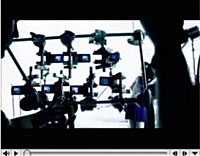 A multiplicity of mobiles (which look like Sony Ericsson k750i’s to us) were set up on frames and tripods with handheld footage recorded by four crew members who wandered around the band as they played, with the footage being sent via Bluetooth to laptops.
A multiplicity of mobiles (which look like Sony Ericsson k750i’s to us) were set up on frames and tripods with handheld footage recorded by four crew members who wandered around the band as they played, with the footage being sent via Bluetooth to laptops. The director of music video, Grant Marshall from Film Headquarters tries to explain, ‘We came up with this idea 18 months ago but couldn’t find a band that would embrace the risk and vision. P.U.S.A loved the concept and were brave enough to undertake the risk. This was a fantastic experience for all of us. The band was fabulous and incredibly professional.”
The director of music video, Grant Marshall from Film Headquarters tries to explain, ‘We came up with this idea 18 months ago but couldn’t find a band that would embrace the risk and vision. P.U.S.A loved the concept and were brave enough to undertake the risk. This was a fantastic experience for all of us. The band was fabulous and incredibly professional.”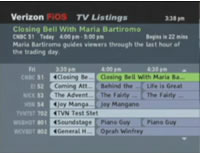 Verizon has launched an IPTV service in Keller, Texas delivered over their fiber-to-the-premises network.
Verizon has launched an IPTV service in Keller, Texas delivered over their fiber-to-the-premises network. Verizon are offers three set-top boxes: standard definition for $3.95/month; HD for $9.95/month; and a digital video recorder set-top box with HD channels for $12.95 permonth. Content packages between $13/month – $40/month are layer on top of this.
Verizon are offers three set-top boxes: standard definition for $3.95/month; HD for $9.95/month; and a digital video recorder set-top box with HD channels for $12.95 permonth. Content packages between $13/month – $40/month are layer on top of this. Following on from his review of the
Following on from his review of the 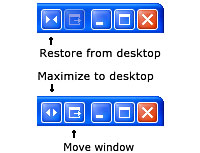 With support for more than ten monitors, UltraMon adds a raft of user-configurable tools to help users get a manly grip on their acres of screen real estate.
With support for more than ten monitors, UltraMon adds a raft of user-configurable tools to help users get a manly grip on their acres of screen real estate.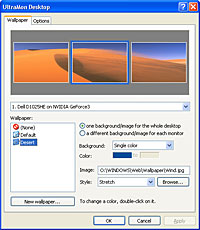 These little fellas let you quickly shunt programs across to other screens with a single click, or maximise a single window across the entire desktop.
These little fellas let you quickly shunt programs across to other screens with a single click, or maximise a single window across the entire desktop.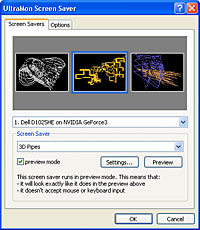 The program also lets you stretch desktop wallpapers and screen savers across multiple screens or set a different picture and screen saver for each screen, which can look way cool!
The program also lets you stretch desktop wallpapers and screen savers across multiple screens or set a different picture and screen saver for each screen, which can look way cool! Neat Idea!
Neat Idea! They’ve done it again
They’ve done it again It’s like the Middle Ages all over again!
It’s like the Middle Ages all over again!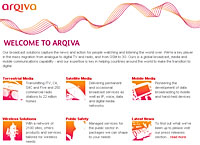 UK operator O2 has announced a mobile TV pilot letting 400 customers in Oxford to choose from 16 channels, featuring popular shows such as Lost, EastEnders, Coronation Street
UK operator O2 has announced a mobile TV pilot letting 400 customers in Oxford to choose from 16 channels, featuring popular shows such as Lost, EastEnders, Coronation Street O2’s chief technology officer, Dave Williams, feels that the trial will help in establishing a model for more projects in the future, commenting. “By establishing relationships through activities such as this, we hope that potential challenges will be minimised and mobile TV becomes a commercial reality sooner than is currently possible.”
O2’s chief technology officer, Dave Williams, feels that the trial will help in establishing a model for more projects in the future, commenting. “By establishing relationships through activities such as this, we hope that potential challenges will be minimised and mobile TV becomes a commercial reality sooner than is currently possible.”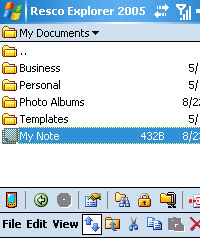 With Pocket PCs offering more and more storage space and applications shunting files all over the place, it’s getting increasingly difficult to manage the data held on a handheld device.
With Pocket PCs offering more and more storage space and applications shunting files all over the place, it’s getting increasingly difficult to manage the data held on a handheld device.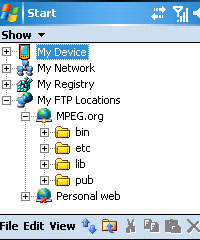 Serving up an arm-long list of features, Resco manages to combine the functions of a host of different applications and meld them into one sophisticated, do-it-all, integrated solution.
Serving up an arm-long list of features, Resco manages to combine the functions of a host of different applications and meld them into one sophisticated, do-it-all, integrated solution.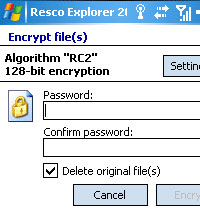 Files can be encrypted from within the program (and from a desktop applet) enabling data to be organised and secured within the same interface. Neat.
Files can be encrypted from within the program (and from a desktop applet) enabling data to be organised and secured within the same interface. Neat.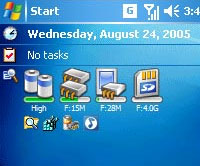 Add to that the improved support for compression – letting users save files at different levels of compression – and a new Today plug-in providing on battery status and free storage/memory and you’ve got a Five Star application that is an absolute must for all Pocket PC users.
Add to that the improved support for compression – letting users save files at different levels of compression – and a new Today plug-in providing on battery status and free storage/memory and you’ve got a Five Star application that is an absolute must for all Pocket PC users. BT has today set-up a new division, known as OpenReach. They’ve been under pressure from some time from competitors and regulators to curb their monopolistic tendencies (they still own over 85% if the infrastructure in the UK). There has even been talk of splitting BT up – although OfCom has currently reject this.
BT has today set-up a new division, known as OpenReach. They’ve been under pressure from some time from competitors and regulators to curb their monopolistic tendencies (they still own over 85% if the infrastructure in the UK). There has even been talk of splitting BT up – although OfCom has currently reject this.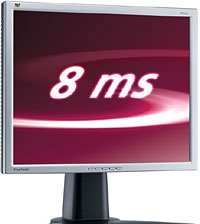 The trouble with CRT monitors is that they often go fuzzy at such a leisurely rate that you don’t notice the deterioration, but find yourself slowly sitting closer and closer to the screen.
The trouble with CRT monitors is that they often go fuzzy at such a leisurely rate that you don’t notice the deterioration, but find yourself slowly sitting closer and closer to the screen.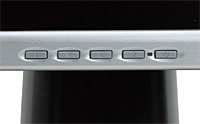 Height, pivot, tilt and swivel could all be adjusted effortlessly, so it’s easy to shimmy monitors into the exact desired position – particularly useful if you’re arranging a multi-screen set up.
Height, pivot, tilt and swivel could all be adjusted effortlessly, so it’s easy to shimmy monitors into the exact desired position – particularly useful if you’re arranging a multi-screen set up.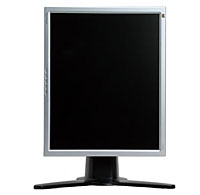 The front panel sports five small buttons – four for monitor adjustments and the fifth for turning the monitor on/off.
The front panel sports five small buttons – four for monitor adjustments and the fifth for turning the monitor on/off. The 800:1 contrast ratio and 250 cd/m² brightness on offer served up vibrant and colourful images – in fact, we had to turn the monitor down from its default 100% brightness setting for fear of being permanently dazzled.
The 800:1 contrast ratio and 250 cd/m² brightness on offer served up vibrant and colourful images – in fact, we had to turn the monitor down from its default 100% brightness setting for fear of being permanently dazzled. Humax have dished out detailed information about their new dual-tuner, Freeview-enabled PVR, the PVR-9200T.
Humax have dished out detailed information about their new dual-tuner, Freeview-enabled PVR, the PVR-9200T. Receiving and recording of pay TV channels is possible through a special CA module.
Receiving and recording of pay TV channels is possible through a special CA module. There’s also a handy USB2.0 port provided for MPEG A/V file transfers between the Duovisio and a PC, letting users play back their digital photos or listen to MP3 files downloaded from a PC.
There’s also a handy USB2.0 port provided for MPEG A/V file transfers between the Duovisio and a PC, letting users play back their digital photos or listen to MP3 files downloaded from a PC.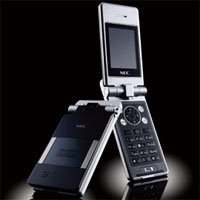 NEC ruled the early days of mobile phone, now with a battle cry of “Thin Is In!” NEC are waving their technological prowess around to the world with the launch of the world’s thinnest foldaway mobile phone.
NEC ruled the early days of mobile phone, now with a battle cry of “Thin Is In!” NEC are waving their technological prowess around to the world with the launch of the world’s thinnest foldaway mobile phone. The clever boffins at NEC have also managed to wedge in PictBridge support, MP3 playback, Java and Bluetooth connectivity.
The clever boffins at NEC have also managed to wedge in PictBridge support, MP3 playback, Java and Bluetooth connectivity.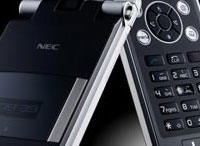 “We will continue to strive to offer the latest, most innovative and most attractive mobile terminal solutions on the market. Boasting compact shape and the latest technologies, our phones allow our customers to choose the right phone for their individual needs in all of our target markets across the globe,” he continued, while laughing at the bulky dimensions of a nearby Motorola RAZR phone.
“We will continue to strive to offer the latest, most innovative and most attractive mobile terminal solutions on the market. Boasting compact shape and the latest technologies, our phones allow our customers to choose the right phone for their individual needs in all of our target markets across the globe,” he continued, while laughing at the bulky dimensions of a nearby Motorola RAZR phone.